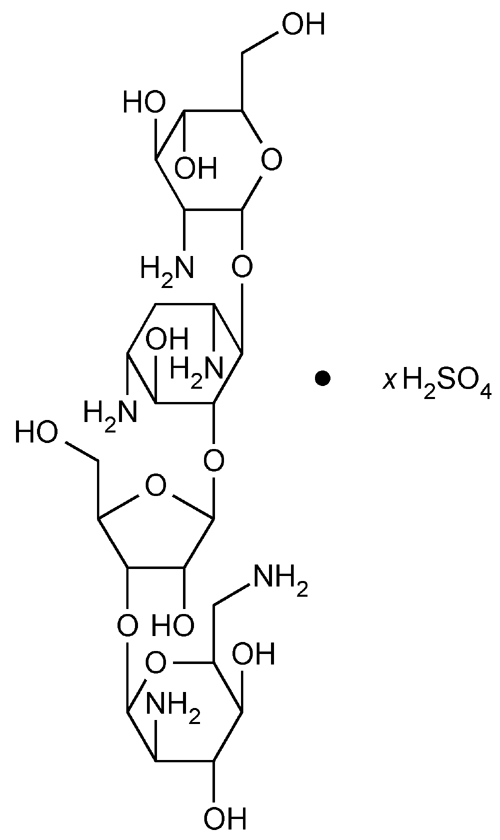Paromomycin Sulfate
d-Streptamine, [O-2-amino-2-deoxy-
O-2,6-Diamino-2,6-dideoxy-
Base 615.64
» Paromomycin Sulfate is the sulfate salt of an antibiotic substance or substances produced by the growth of Streptomyces rimosus var. paromomycinus, or a mixture of two or more such salts. It has a potency equivalent to not less than 675 µg of paromomycin (C23H45N5O14) per mg, calculated on the dried basis.
Packaging and storage—
Preserve in tight containers.
Identification—
A:
Prepare a test solution in water containing 10 mg of paromomycin per mL. Apply 25 µL of this solution and 25 µL of a Standard solution of USP Paromomycin Sulfate RS containing 10 mg of paromomycin per mL to a suitable thin-layer chromatographic plate (see Chromatography  621
621 ) coated with a 0.25-mm layer of chromatographic silica gel. Allow the spots to dry, place the plate in a developing chamber, and develop the chromatogram in a solvent system consisting of a mixture of freshly prepared ammonium acetate solution (4 in 100), n-propyl alcohol, and ammonium hydroxide (30:10:6) until the solvent front has moved about three-fourths of the length of the plate. Remove the plate from the chamber, mark the solvent front, and allow it to air-dry for 10 minutes. Heat the plate at 105
) coated with a 0.25-mm layer of chromatographic silica gel. Allow the spots to dry, place the plate in a developing chamber, and develop the chromatogram in a solvent system consisting of a mixture of freshly prepared ammonium acetate solution (4 in 100), n-propyl alcohol, and ammonium hydroxide (30:10:6) until the solvent front has moved about three-fourths of the length of the plate. Remove the plate from the chamber, mark the solvent front, and allow it to air-dry for 10 minutes. Heat the plate at 105 for 1 hour, allow to cool, and spray with a solution of ninhydrin in butanol (1 in 100). Heat the plate at 105
for 1 hour, allow to cool, and spray with a solution of ninhydrin in butanol (1 in 100). Heat the plate at 105 for 5 minutes: paromomycin appears as a red spot, and the RF value of the principal spot obtained from the test solution corresponds to that obtained from the Standard solution.
for 5 minutes: paromomycin appears as a red spot, and the RF value of the principal spot obtained from the test solution corresponds to that obtained from the Standard solution.
B:
It meets the requirements of the tests for Sulfate  191
191 .
.
pH  791
791 :
between 5.0 and 7.5, in a solution (3 in 100).
:
between 5.0 and 7.5, in a solution (3 in 100).
Loss on drying  731
731 —
Dry about 100 mg in a capillary-stoppered bottle in vacuum at a pressure not exceeding 5 mm of mercury at 60
—
Dry about 100 mg in a capillary-stoppered bottle in vacuum at a pressure not exceeding 5 mm of mercury at 60 for 3 hours: it loses not more than 5.0% of its weight.
for 3 hours: it loses not more than 5.0% of its weight.
Residue on ignition  281
281 :
not more than 2.0%, the charred residue being moistened with 2 mL of nitric acid and 5 drops of sulfuric acid.
:
not more than 2.0%, the charred residue being moistened with 2 mL of nitric acid and 5 drops of sulfuric acid.
Assay—
Proceed with Paromomycin Sulfate as directed under Antibiotics—Microbial Assays  81
81 .
.
Auxiliary Information—
Please check for your question in the FAQs before contacting USP.
| Topic/Question | Contact | Expert Committee |
| Monograph | Ahalya Wise, M.S.
Scientist 1-301-816-8161 |
(MDANT05) Monograph Development-Antibiotics |
| Reference Standards | Lili Wang, Technical Services Scientist 1-301-816-8129 RSTech@usp.org |
USP32–NF27 Page 3213
